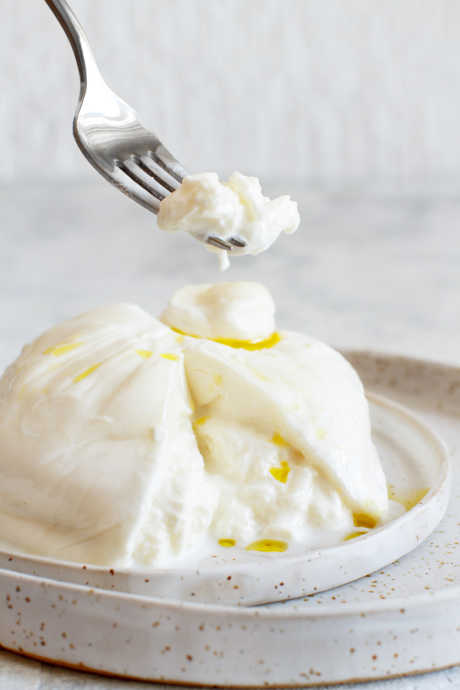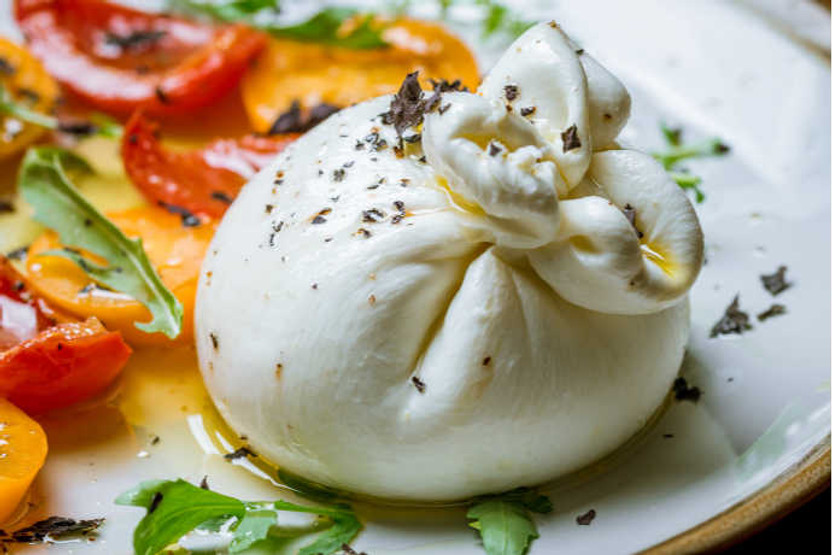Burrata Cheese: More Than Mozzarella
Posted by Julie on Jun 10th 2020
It should be clear by now that we’re big fans of cheese. We’ve covered a wide variety of hard and soft cheeses, along with the details behind how they’re made. We’ve explored options for creating an irresistible cheese board. We’ve also broken down an essential summer appetizer and salad -- caprese -- in which mozzarella is the star of the show. Now we’ll talk about burrata. If you aren’t already familiar with this trendy, versatile cheese, get ready for a real treat.
What Is Burrata?
Chowhound describes burrata as “the piñata of the cheese world.” But in the case of burrata, the good stuff is found both on the inside and outside.

Burrata came about as a way to reduce waste when making mozzarella. Warm mozzarella cheese is stretched around leftover mozzarella curds, or stracciatella. Then cream is added to the curds before the mozzarella shell is tied in a knot. This decadent package is then sliced open or torn apart for serving.
Burrata vs. Mozzarella
If burrata is made from mozzarella, what makes it different from mozzarella? While the outside shell resembles a ball of fresh mozzarella, the inside contents give burrata a far different texture. The Spruce Eats describes burrata’s texture as similar to ricotta cheese -- creamy and spreadable. The Kitchn notes that burrata has a “milky, buttery flavor.” It’s rich, but lighter than mozzarella.
How to Serve Burrata
Whether you use burrata as an ingredient in a recipe, or you get creative with it on your own, keep these two key points in mind. One, burrata is a fresh cheese. Unlike mozzarella, which can be packaged in blocks or pre-shredded, burrata doesn’t keep long. For the best, freshest flavor, eat burrata the day you buy it. Eat all of it, though we doubt there will be any leftovers.
Second, let burrata come to room temperature before serving. The flavors will be far more pronounced when the cheese isn’t chilled. This same guidance applies even if you plan to add it to a hot dish, like pasta or pizza. Burrata doesn’t melt like mozzarella does; it’s best when added after the pizza comes out of the oven, or torn into shreds over the top of a bowl of pasta.
But you don’t have to make a full meal to incorporate burrata. It’s just as good when served with a green salad or in place of mozzarella with caprese. As an appetizer, serve burrata with bread or crackers. Add a dash of salt and a splash of olive oil, balsamic vinegar, or both.
Burrata Recipes
If you’d rather try burrata in the context of a recipe, check out this one from Ina Garten, Barefoot Contessa. It’s so simple, but so elegant at the same time. It also doubles as both an appetizer and a salad, depending on how you plate it. Slice burrata in half and serve with sliced heirloom tomatoes, olive oil, balsamic vinegar, kosher salt, and pepper, with some fresh basil on top. Then add garlic toast made from sliced baguettes. Brush each slice with olive oil and top with kosher salt and pepper before baking. When the toast comes out of the oven, rub the seasoned side with the cut side of a clove of fresh garlic.
We also like this recipe from Bon Appetit that’s perfect for summer, with fresh peaches and tomatoes. Slice them and toss them with a dressing made from olive oil, rice vinegar, mild hot sauce, honey, and kosher salt. Let the flavors meld for a few minutes, and then transfer everything to a serving bowl or platter. Tear apart the burrata, add it to the tomatoes and peaches, and pour a little more dressing over the top. This salad comes together in a snap; just be sure to take the burrata out of the refrigerator half an hour in advance.
 Free shipping over $49
Free shipping over $49










